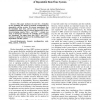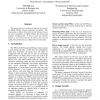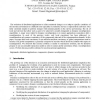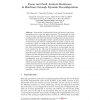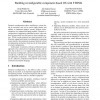CORR
2010
Springer
14 years 4 months ago
2010
Springer
This paper motivates the need for a formalism for the modelling and analysis of dynamic reconfiguration of dependable real-time systems. We present requirements that the formalism ...
ENTCS
2002
14 years 7 months ago
2002
This paper presents a mechanism for dynamic reconfiguration of component-based applications and its fault tolerance strategy. The mechanism, named generic connector, allows compos...
IJES
2006
14 years 7 months ago
2006
This paper describes novel methods of exploiting the partial, dynamic reconfiguration capabilities of Xilinx Virtex V1000 FPGAs to manage single-event upset (SEU) faults due to rad...
IJES
2006
14 years 7 months ago
2006
This paper proposes a solution to improve the security of SRAM FPGAs through bitstream encryption. This proposition is distinct from other works because it uses the latest capabil...
PDPTA
2003
14 years 8 months ago
2003
The evolution of distributed applications to reflect structural changes or to adapt to specific conditions of the run-time environment is a difficult issue especially if continuou...
DOA
2001
14 years 8 months ago
2001
Distributed systems with high availability requirements have to support some form of dynamic reconfiguration. This means that they must provide the ability to be maintained or upg...
CHES
2008
Springer
14 years 9 months ago
2008
Springer
Dynamically reconfigurable systems are known to have many advantages such as area and power reduction. The drawbacks of these systems are the reconfiguration delay and the overhead...
OOIS
2000
Springer
14 years 11 months ago
2000
Springer
ABSTRACT. Cost-effective reconfiguration in ODBMSs is difficult to achieve due to the tradeoff between modularity and efficiency. Existing ODBMS designs offer limited reconfigurabi...
EUROMICRO
2006
IEEE
14 years 11 months ago
2006
IEEE
Dynamic reconfiguration allows modifying a system during its execution, and can be used to apply patches and updates, to implement adaptive systems, dynamic instrumentation, or to...
ESOP
2006
Springer
14 years 11 months ago
2006
Springer
We define a core language combining computational and architectural primitives, and study how static typing may be used to ensure safety properties of component composition and dyn...
